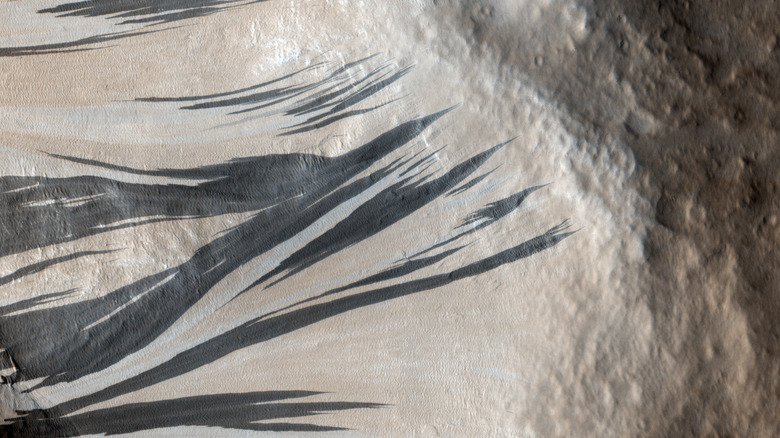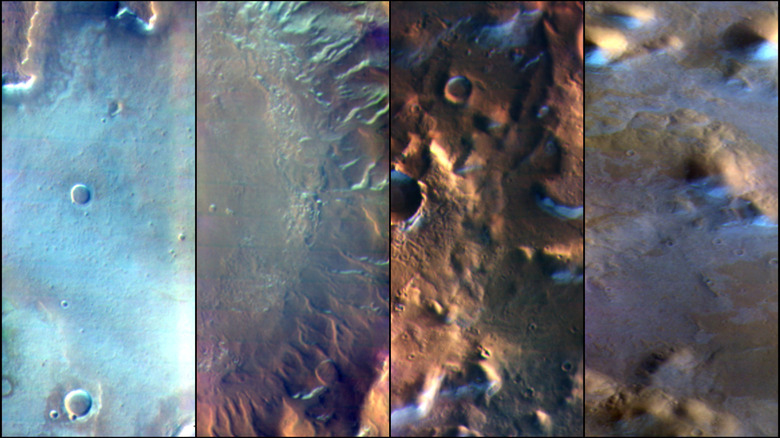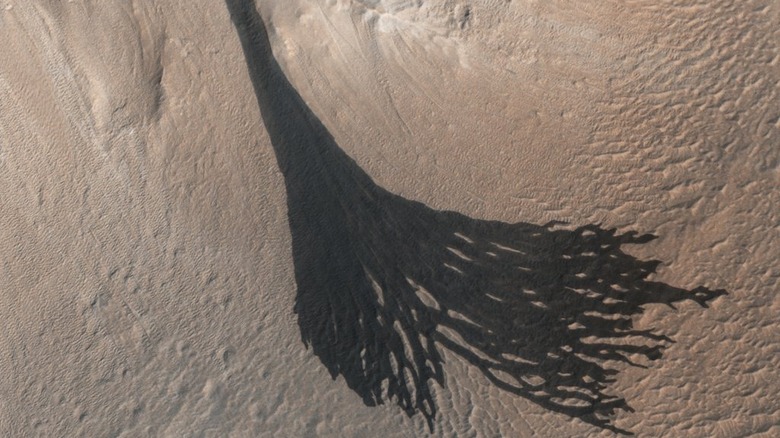How Dust Avalanches On Mars Reshape The Planet's Surface
One of the biggest features of Mars affecting the weather there is dust. Because Mars is smaller than Earth, it has lower gravity at around one-third of the strength of gravity on Earth (via NASA). Mars also has a thin atmosphere, which is just 1% of the density of the atmosphere on Earth. Taken together, these two facts mean that the surface on Mars experiences fast changes in temperature and high winds, which whip up the small particles of dust on the surface into dust storms that roll across regions and sometimes across the entire planet (via NASA).
This means that dust has a big effect on the Mars environment, ones as severe as bringing winter to an early end in some cases. Not to mention the effects on Martian explorers, like the Opportunity rover, whose 15-year mission came to an end due to a dust storm that blew dust over its solar panels, stopping them from recharging the rover's batteries.
But it turns out that dust doesn't only shape the Martian weather — it also shapes the Martian surface. A recent study, published in the Journal of Geophysical Research: Planets has found that strange dust avalanches could be related to a mystery regarding frost (via JPL).
The study used data from the venerable Mars Odyssey mission, an orbiter launched all the way back in 2001 when it took images of the Martian surface. The orbiter has three science instruments on board, including an instrument for measuring radiation, a spectrometer, and an imager (via NASA). This imager can look in both visible light and infrared wavelengths, and it uses both to image the surface. That's where the puzzle began.
Invisible frost
The images taken by Odyssey's visible light instrument showed frost on slopes on the Martian surface, which appear as streaks of blue. The presence of the frost itself makes sense. When the sun sets on Mars it gets extremely cold there, with surface temperatures dropping as low as minus 200 degrees Fahrenheit (via space.com). This cold makes some amount of carbon dioxide, which is plentiful in the Martian atmosphere, freeze into dry ice.
However, when the researchers compared images taken in the infrared, they saw lots more of this frost spread over a wider area. Infrared images can show heat, as hot objects give off infrared energy. That means that infrared instruments can detect cold as well, by seeing areas with less infrared energy being given off. In the images taken of the same Martian slopes in infrared, researchers saw patches of cold that spread beyond the patches of frost they saw in the visible light images.
At first, they thought this might mean there was frost just below the surface. "Our first thought was ice could be buried there," Lucas Lange, an intern at NASA's Jet Propulsion Laboratory who worked on the research, explained. But that explanation didn't fit with what they knew about the environment they were looking at. "Dry ice is plentiful near Mars' poles, but we were looking closer to the equator of the planet, where it's generally too warm for dry ice frost to form," Lange said.
Solving the mystery
The researchers decided that dust must be getting mixed up with the frost, creating "dirty frost" which is impossible to see in the visible light wavelength but can still be seen in the infrared. This is a process on Mars unlike anything on Earth, according to one of the authors of the paper, Chris Edwards of Northern Arizona University. "Every time we send a mission to Mars, we discover exotic new processes," Edwards said. "We don't have anything exactly like a slope streak on Earth. You have to think beyond your experiences on Earth to understand Mars."
The new study found that when the sun rises on Mars, the dry ice melts extremely quickly as the atmosphere is so thin. The ice sublimates, which creates winds, and these winds are sometimes strong enough to start blowing around dust on the surface. On a steep slope, this can cause a dust avalanche. The presence of this dry ice near the surface helps to create these dust avalanches, which create the striking dark streaks seen from orbit.
And this dirty frost can also explain some dramatic features of the Martian surface. On some slopes on Mars, you can see dark lines called slope streaks which can stretch for as long as 3,300 feet. Researchers suspected that these streaks were caused by dust avalanches, as the dust moves down the slope and exposes darker colored rock beneath as it goes. So the interplay of the dust and the frost is reshaping the Martian landscape in a way we've never seen before on our own planet.
The full research can be found in the study titled "Gardening of the Martian Regolith by Diurnal CO2 Frost and the Formation of Slope Streaks" published in the Journal of Geophysical Research: Planets.


